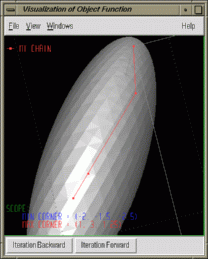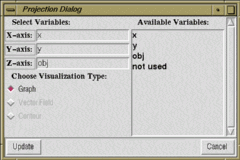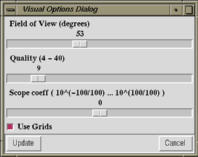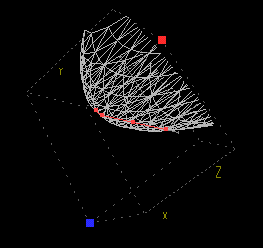



- Open Animation...
- Open an existing animation file from the disk.
- Save Animation...
- Save a newly recorded animation.
- Save Animation as...
- Save a newly recorded animation with a new name.
- Animation Player...
- Launche the Animation Player.
- Quit ...
- Quit the Visualization Window.
- xy-projection
- The direction of the view is perpendicular to xy-surface.
- (See also Pointing Device)
- xz-projection
- The direction of the view is perpendicular to xz-surface.
- (See also Pointing Device)
- zy-projection
- The direction of the view is perpendicular to zy-surface.
- (See also Pointing Device)
- xyz-projection
- By default, the direction of the view runs parallel with vector (-1,-1,-1).
- (See also Pointing Device)
- Changing Eye Point/Target Point
- When changing the eye point, the target point is fixed. And vice versa.
- (See also Pointing Device)
- Previous Iteration
- All the method combinations are stepped one iteration backwards (if possible)
- Next Iteration
- All the method combinations are stepped one iteration forwards (if possible)
- Projection Window...
- Opens the Projection dialog
- Visual Options Window...
- Opens the Visual options
- Animation Player...
- Starts Animation player



Animation player allows you to record sequences of translations and rotations of the scene. Animation player also records all projection changes and view changes. To start recording, press the Rec button once. When recorded, press the Stop button. To play newly recorded animation, just press the Play button. After recording, the sequence can be saved in a file (File | Save Animation).
